About the Artist
Ramesh Gorjala, also known as Ramesh Gorzala, is a renowned contemporary artist hailing from the state of Telangana, India. He was born in 1979 in Srikalahasti, a town known for its rich artistic heritage. Ramesh Gorjala comes from a family of traditional Kalamkari artists, and he inherited the skills and passion for art from his father.
Gorjala’s artistic style is deeply rooted in the traditional Indian art form of Kalamkari, which involves intricate hand painting on textiles using natural dyes. However, he has taken this ancient art form to new heights by incorporating modern elements and techniques into his work. His innovative approach has earned him recognition and acclaim both in India and internationally.
One of the distinguishing features of Gorjala’s art is his unique blend of mythology, folklore, and contemporary narratives. He skillfully combines these themes to create visually captivating and thought-provoking artworks. His paintings often depict mythological stories, gods, goddesses, and legendary figures, infused with vibrant colors, intricate patterns, and intricate detailing.
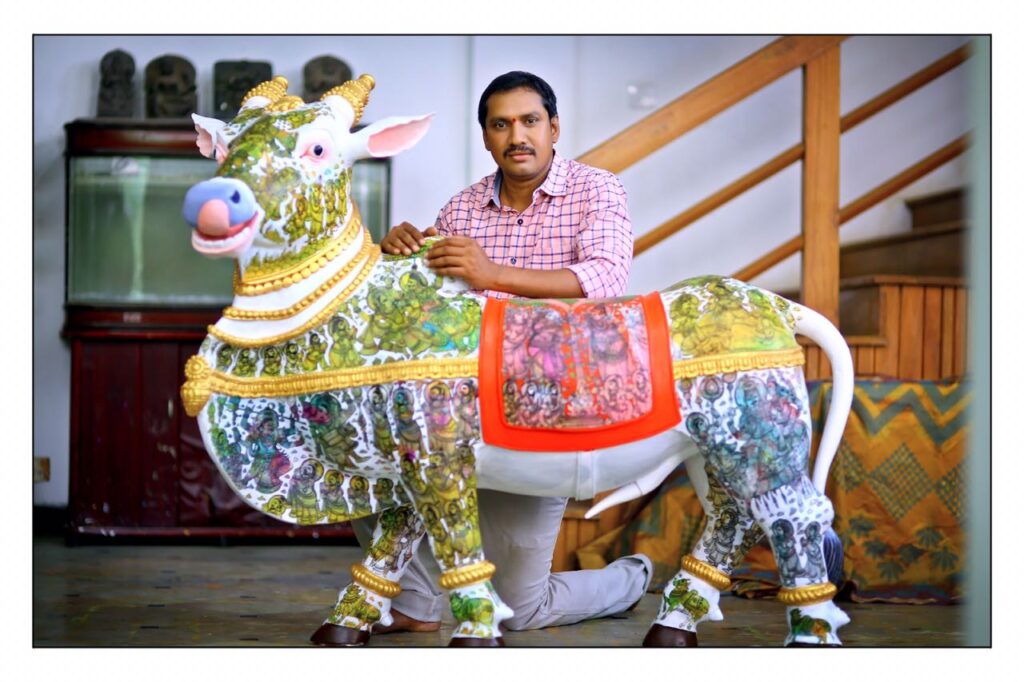

Lord Vishnu and his Avatars
Lord Vishnu is one of the principal deities in Hinduism and is considered one of the Holy Trinity, known as the “Trimurti,” along with Brahma and Shiva. He is revered as the preserver and protector of the universe, playing a central role in Hindu cosmology and mythology. Lord Vishnu is often depicted as having a blue complexion and is typically portrayed with four arms, each holding a symbolic object: a conch shell (shankha), a discus (chakra), a mace (gada), and a lotus flower (padma). These represent various aspects of his divine power and responsibility.
Vishnu is believed to incarnate on Earth whenever the world is in grave danger or imbalance to restore cosmic order and righteousness. These incarnations are known as “avatars,” and some of the most famous ones include Lord Rama and Lord Krishna. Lord Vishnu is also associated with qualities such as compassion, love, and mercy, and he is often called the “Preserver” because of his role in maintaining the balance between creation and destruction in the universe.
Worship of Lord Vishnu is widespread throughout India and among Hindu communities around the world. Devotees seek his blessings and guidance for various aspects of life, including spiritual growth, protection, and salvation. Lord Vishnu’s presence in Hindu mythology and philosophy reflects the intricate tapestry of beliefs and values that shape the Hindu religion and culture.
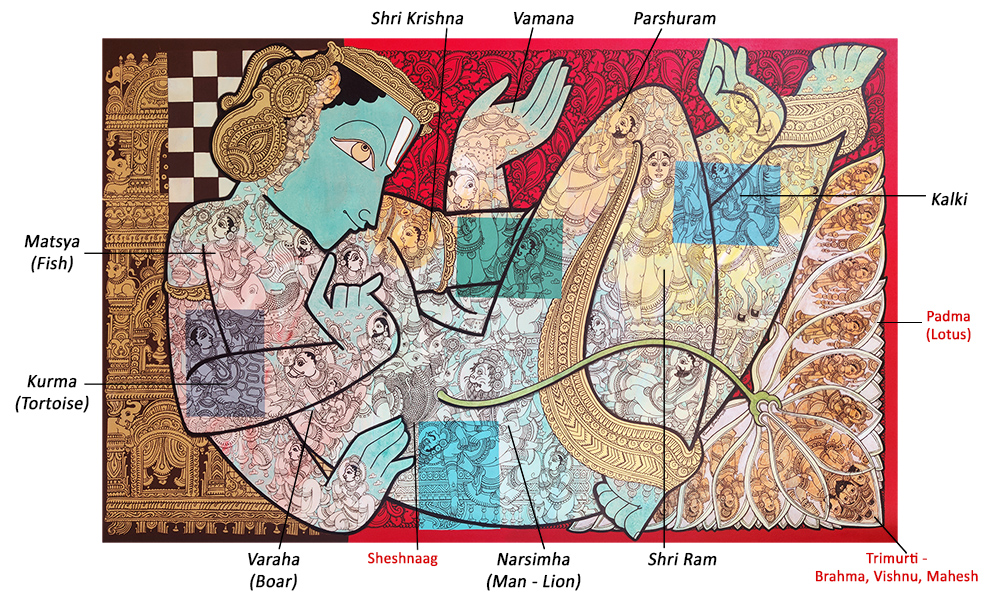

Dasavatara
Let’s take a closer look at the 10 avatars of Vishnu below!
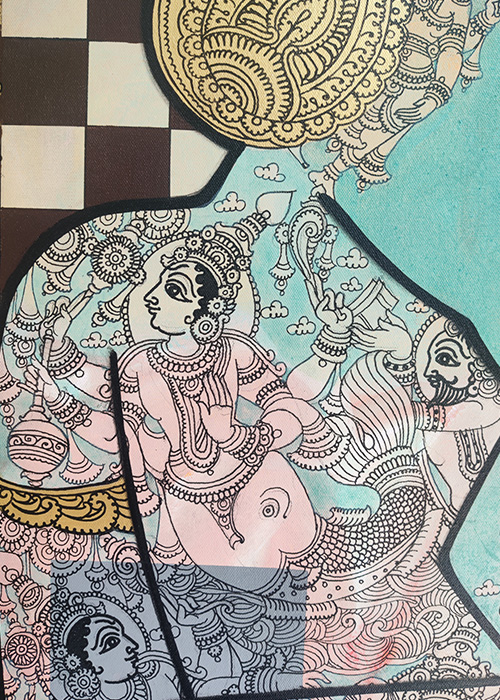

Matsya (Fish)
Vishnu assumed the form of a fish to save the sage Manu from a devastating flood. He guided Manu’s boat, which carried the seeds of all life and important knowledge, to safety. As the waters receded, Matsya recovered the scriptures that had been lost and restored them to humanity, symbolizing the preservation of wisdom and life.
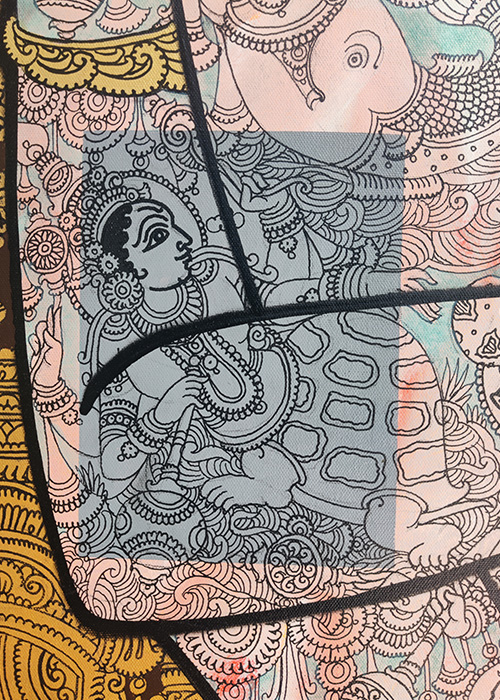

Kurma (Tortoise)
During the churning of the cosmic ocean, Vishnu took the form of a tortoise to support Mount Mandara, used as a churning rod, on his back. This allowed the gods and demons to churn the ocean for the nectar of immortality (amrita). Kurma’s role showcased Vishnu’s stability and willingness to bear the weight of the universe for the greater good.
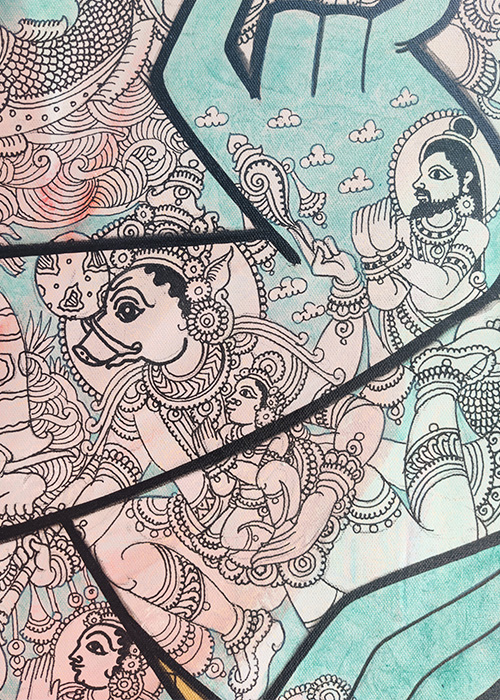

Varaha (Boar)
Vishnu incarnated as Varaha, a boar, to rescue the Earth goddess Bhudevi. She had been abducted and submerged in the cosmic ocean by the demon Hiranyaksha. Varaha defeated the demon in a fierce battle, raised Bhudevi from the depths, and restored her to her rightful place, symbolizing the triumph of good over evil.
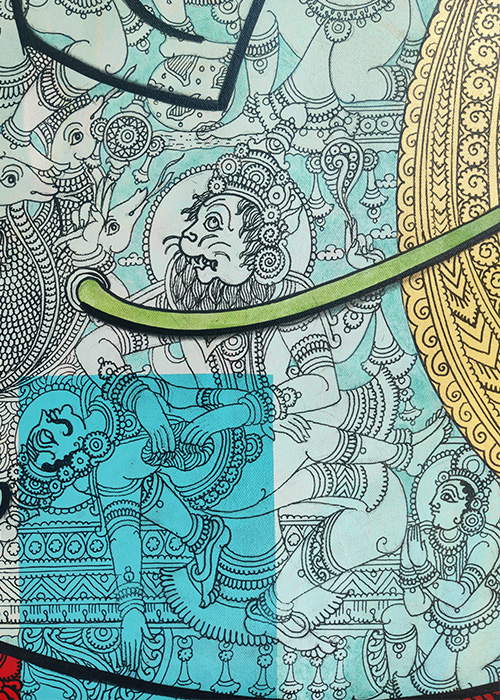

Narasimha (Man - Lion)
Vishnu’s fourth avatar, Narasimha, emerged to protect his devotee Prahlada and uphold cosmic order. Narasimha was neither fully man nor beast, appearing at dusk to defeat the demon king Hiranyakashipu, who was immune to death by man or animal. This unique form illustrated the fulfillment of a divine boon while maintaining balance.
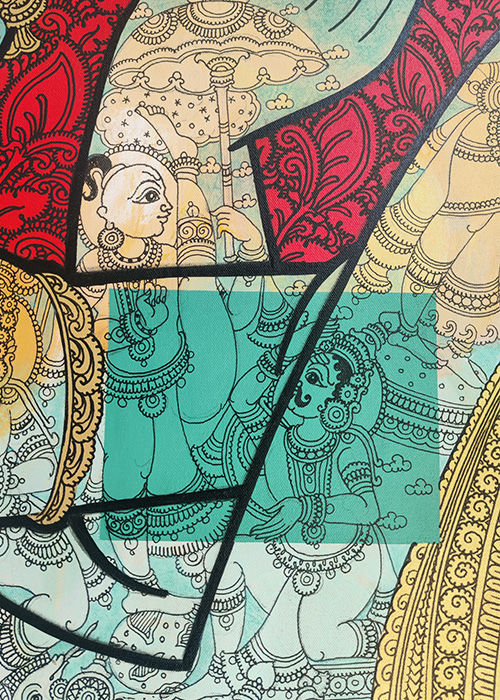

Vamana (Dwarf)
Vishnu incarnated as a dwarf Brahmin, Vamana, to curtail the power of the demon king Bali. Disguised as Vamana, Vishnu approached Bali and requested three paces of land. With his first two steps, Vamana covered the entire universe. For the third step, Bali offered his head, signifying humility and the restoration of cosmic equilibrium.
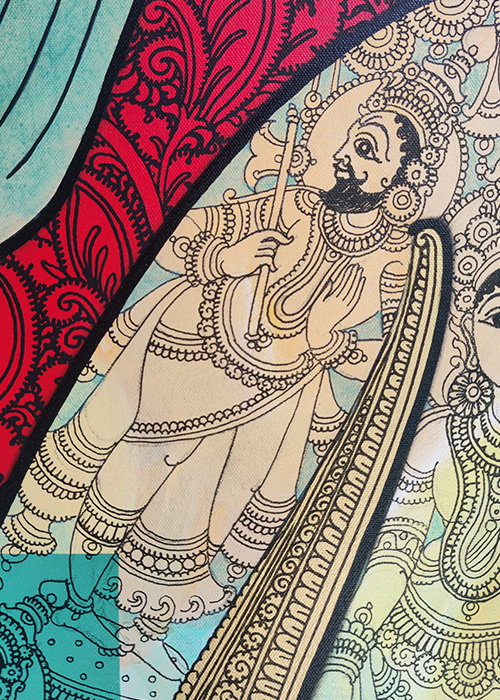

Parshurama
As Parashurama, Vishnu manifested to eradicate oppressive Kshatriya rulers who had become corrupt. Parashurama, wielding a formidable axe, embarked on a mission to cleanse the world of their tyranny, ensuring a just and balanced society.
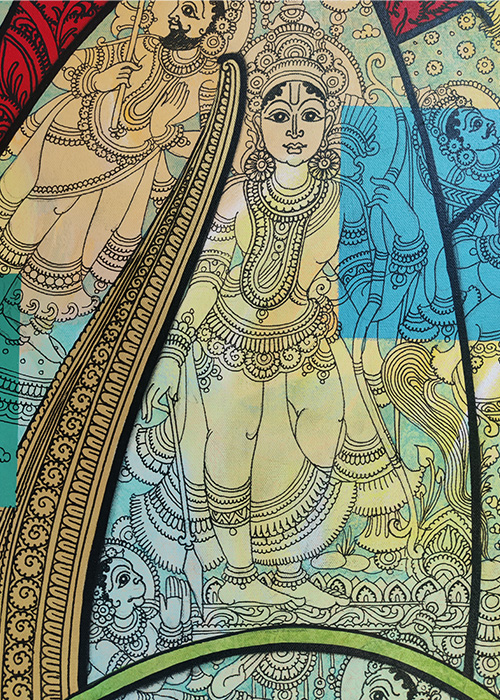

Shri Ram
Lord Rama, the seventh avatar, is the protagonist of the Ramayana. Vishnu incarnated as Rama to defeat the demon king Ravana, who had abducted Rama’s wife, Sita. Rama’s unwavering adherence to dharma, along with his loyalty, righteousness, and devotion, showcases the qualities of an ideal ruler and human being.
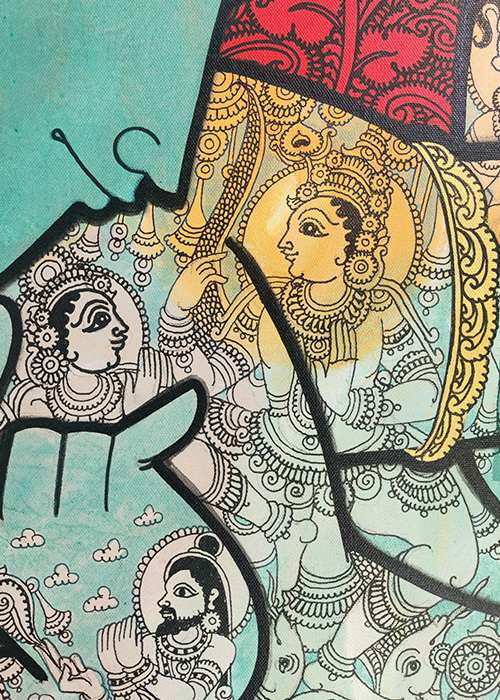

Shri Krishna
Vishnu incarnated as Krishna, a divine and charismatic figure. Krishna played a pivotal role in the Mahabharata, delivering the profound teachings of the Bhagavad Gita to Arjuna on the battlefield. His actions, interactions, and guidance illustrated the path of devotion, selflessness, and divine love.
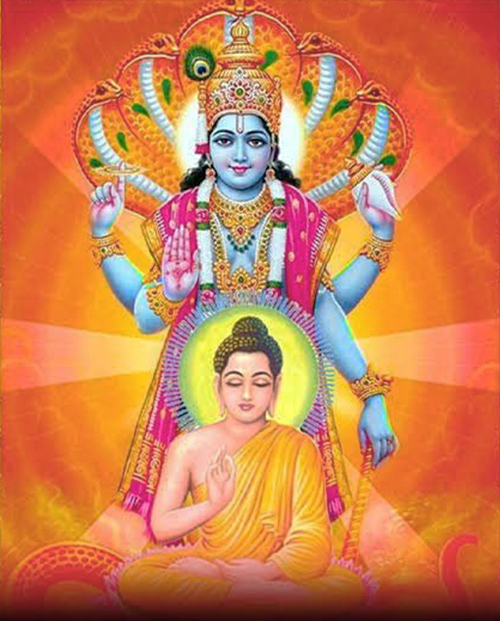

Buddha*
Vishnu’s 9th avatar, Buddha, appeared during a time of spiritual confusion. His teachings emphasized non-violence, compassion, and the pursuit of enlightenment, guiding humanity away from suffering and ignorance towards a more enlightened path.
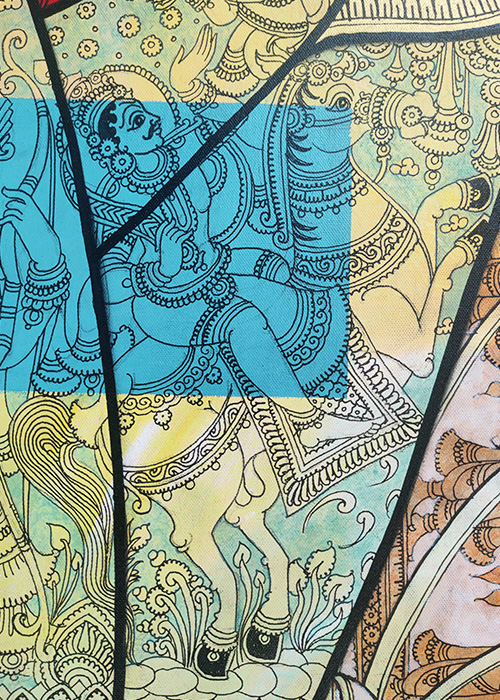

Kalki
In the future, Vishnu is prophesied to incarnate as Kalki, a warrior mounted on a white horse. Kalki will emerge at the end of the current age (Kali Yuga) to restore righteousness (dharma) and rid the world of corruption and evil, initiating a new cycle of time.
*Ramesh Gorjala chooses to not use the Buddha avatar in his painting. He uses nav-avatars in this particular painting. The idea that the Buddha was an avatar of Vishnu is a concept found in some Hindu traditions, particularly in Vaishnavism. This idea however is a theological belief held by some Hindus but is not universally accepted within either religion, making Buddhism and Hinduism distinct religions with separate belief systems and practices.
*In Hindu mythology, Balarama is the elder half-brother of Krishna. Balarama is sometimes considered one of the 10 avatars (incarnations) of the god Vishnu. In the Sri Vaishnava lists, Balarama is the eighth avatar of Vishnu, and Krishna is the ninth.
These avatars collectively reflect Vishnu’s commitment to maintaining cosmic balance, protecting dharma, and guiding humanity towards a path of righteousness and enlightenment.
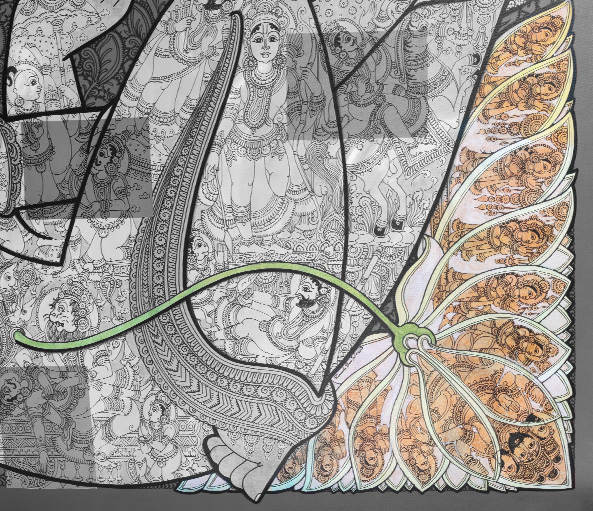

The significance of the Lotus
The lotus is intricately intertwined with Lord Vishnu in Hindu tradition. One of the most prevalent depictions of Vishnu is him resting or seated on a celestial lotus, known as the “Padma” or “Kamala.” This portrayal emphasizes Vishnu’s role as the cosmic preserver and sustainer of the universe. The lotus, emerging from murky waters untouched by impurities, represents divine purity and spiritual transcendence. It signifies Vishnu’s ability to remain untainted by the material world’s distractions and temptations, and he is often referred to as “Padmanabha,” meaning “the one with a lotus navel,” very intricately depicted in this painting.
The unfolding petals of the lotus also hold symbolic significance. They signify the process of creation and the universe’s evolution from its formless state into manifest existence. Vishnu’s association with the lotus underscores his role as the source of creation and the cosmic ocean on which the lotus blooms.
Furthermore, the lotus is linked to Goddess Lakshmi, Vishnu’s consort, who is often depicted seated on a lotus. This connection represents the harmonious union of preservation and abundance. Goddess Lakshmi, known as “Padma,” symbolizes prosperity, wealth, and well-being, and her presence alongside Vishnu on the lotus highlights their divine partnership in maintaining cosmic order and providing blessings to their devotees.
The Trimurti
The trio of Brahma, Vishnu, and Shiva (also known as Mahesh) form the Trimurti in Hinduism, representing the three principal aspects of the divine cosmic functions. They are responsible for the creation, preservation, and destruction of the universe, respectively. To complete the description:
Brahma: The Creator – Brahma is responsible for the creation (Srishti) of the universe and all living beings. He is associated with the aspect of creation and is depicted with four heads and four hands.
Vishnu: The Preserver – Vishnu is the second aspect of the Trimurti and is responsible for the preservation (Sthiti) of the universe. He is believed to sustain and maintain order in the cosmos. Vishnu is known for his avatars, particularly Lord Rama and Lord Krishna, who descend to the earthly realm whenever there is a need to restore balance and righteousness.
Shiva (Mahesh): The Destroyer – Shiva, also known as Mahesh, is the third aspect of the Trimurti and is responsible for the destruction (Samhara) of the universe. However, it’s essential to understand that the destruction aspect is not merely about causing harm but rather about transformation and renewal. Shiva’s role as the destroyer paves the way for new creation and change.
Together, Brahma, Vishnu, and Shiva represent the cyclical nature of existence, where creation arises, is sustained for a time, and eventually undergoes dissolution, only to be recreated again. This cycle is known as the cosmic dance or “Tandava,” where Shiva’s dance symbolizes the eternal rhythm of creation, preservation, and destruction in the universe.
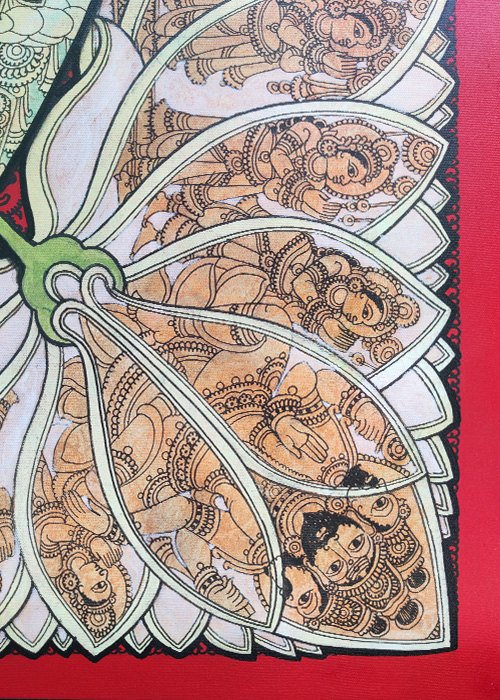

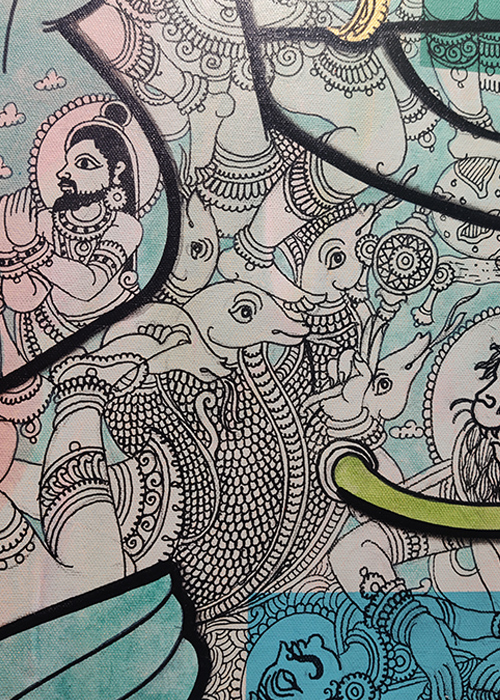

The significance of Sheshnaag
Shesha, also known as Ananta Shesha or simply Ananta, is a prominent figure in Hindu mythology and a divine serpent with multiple heads. The name “Shesha” is derived from the Sanskrit word “shesh,” which means “remainder” or “that which remains.” This name reflects Shesha’s role as the eternal and unchanging support for the entire universe. Shesha is often depicted as a massive serpent with a thousand heads or, in some depictions, as having innumerable heads. He is typically shown coiled and floating in the cosmic ocean, with his heads serving as the throne or bed for Lord Vishnu during Vishnu’s cosmic sleep (Yoganidra).
Shesha is considered a manifestation of the cosmic balance and order in Hindu cosmology. He represents the eternal and unchanging aspect of the universe. His primary role is to support Lord Vishnu, particularly during Vishnu’s cosmic rest on the waters of the Milky Ocean. Vishnu reclines on the coils of Shesha while maintaining the universe. Shesha symbolizes the idea that the universe rests on the eternal support of the divine and that he upholds the cosmic order.
Shesha’s innumerable heads signify his vastness and all-encompassing nature. He is often described as chanting the praises of Lord Vishnu with his heads. In some texts, Shesha is also associated with the concept of time, with each of his heads representing a cosmic cycle. Shesha is revered as a symbol of stability, patience, and unwavering devotion in Hinduism.
Shesha’s close association with Lord Vishnu is evident in his role as the divine couch or throne upon which Vishnu reclines. This relationship emphasizes Vishnu’s role as the preserver (Sthiti) in the Hindu trinity of gods.
Bringing it all together !
Gorjala’s meticulous attention to detail and his mastery of the Kalamkari technique are evident in his artworks. He uses fine lines, intricate brushwork, and a harmonious color palette to bring his subjects to life. His compositions are carefully structured, and he employs a range of textures and layers to add depth and dimension to his paintings.
Steeped in the kalamkari tradition and its warm colors, art by Ramesh Gorjala is unique in its rendition of Indian mythological figures, including Krishna, Vishnu and Ganesha. The large bodies of these Hindu deities fill up the canvas, while their skin becomes the stage for ancient tales acted out by intricately painted figures—each painting literally contains stories within stories. The typical kalamkari process of using a fine pen to accentuate block-printed colors is evident in his work, and he primarily paints in red, orange, brown, blue and gold. (see below – some of his other works of various subjects)
Over the years, Ramesh Gorjala has participated in numerous solo and group exhibitions in India and abroad, showcasing his unique artistic vision. His works have been displayed in prestigious art galleries, museums, and art fairs, attracting art enthusiasts and collectors. Gorjala’s contribution to the world of art has not only revitalized the traditional art form of Kalamkari but also established him as a celebrated contemporary artist pushing the boundaries of Indian art.
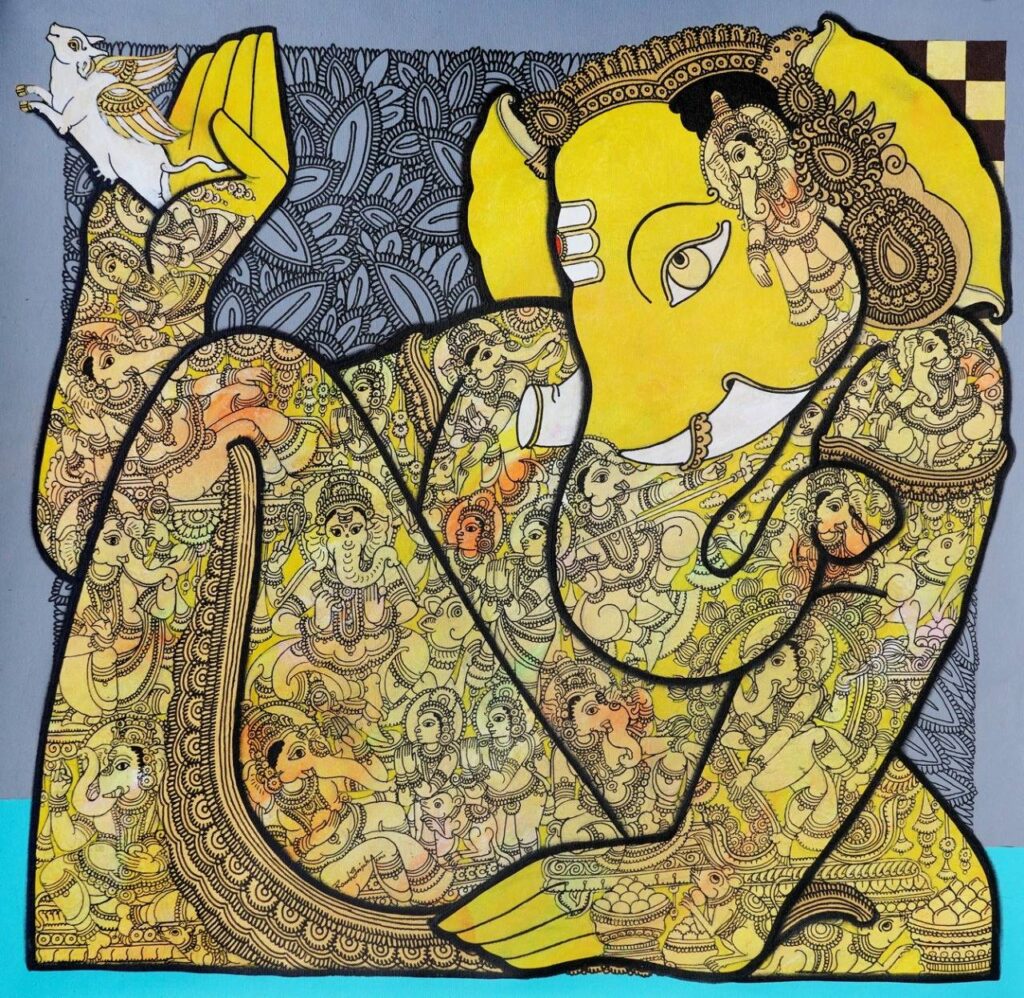

Ganesha
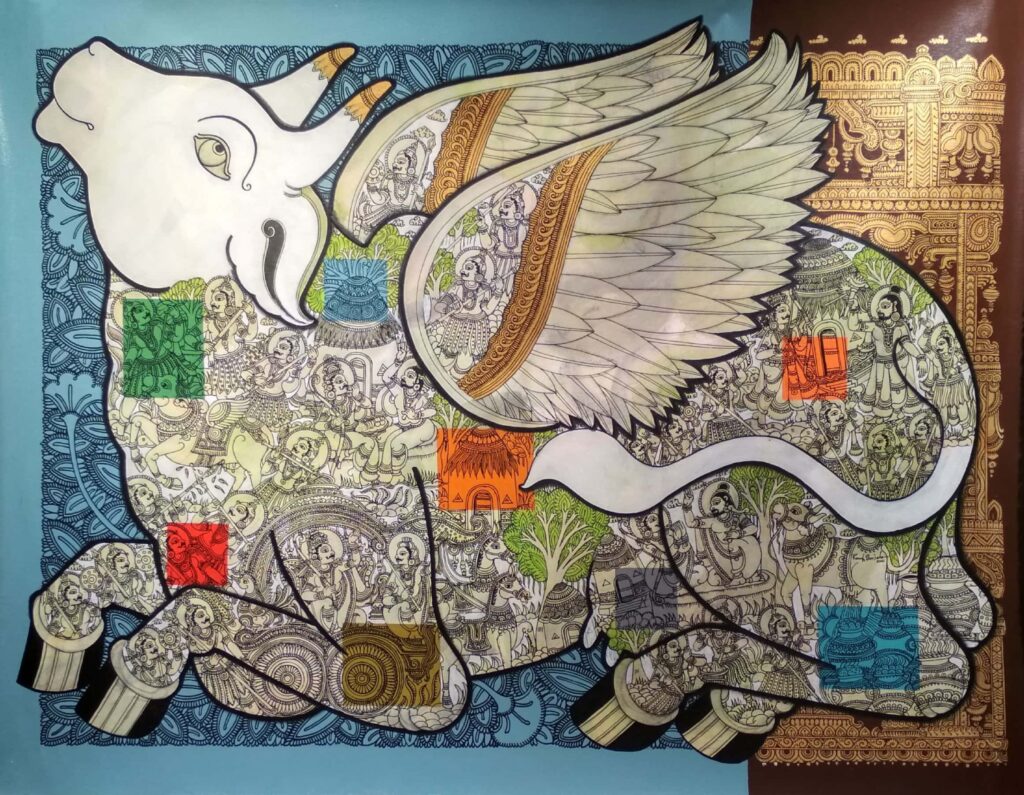

Kamdhenu


Maa Durga
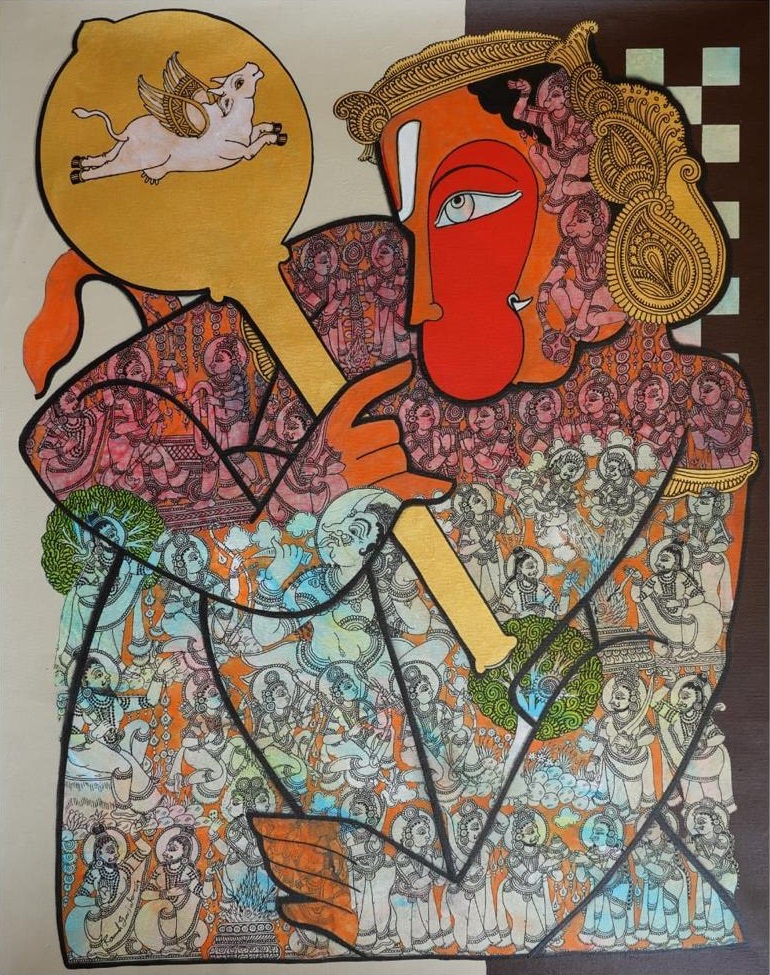

Hanuman




